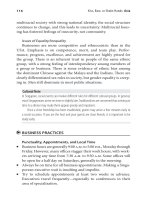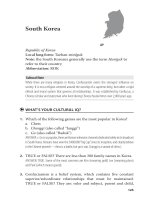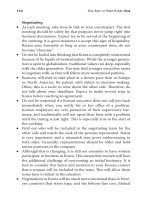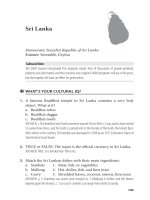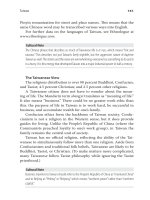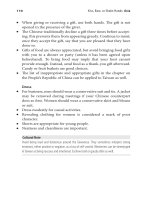How to Understand Business Finance Understand the Business Cycle Manage Your Assets Measure Business Performance Sunday Times Creating Success_2 docx
Bạn đang xem bản rút gọn của tài liệu. Xem và tải ngay bản đầy đủ của tài liệu tại đây (1.41 MB, 18 trang )
26 How to Understand Business Finance
cash to pay for the equipment and install it in our factory (see
earlier, Figure 2.3). Now we need to recruit staff . In reality we don’t
just fi nd someone walking down the street suitably qualifi ed. We
have to advertise or use an agency to recruit staff . Let’s say this
costs us £3,000. We take the £3,000 from cash and place it among
our business expenses on the right-hand side of the board, as
shown in Figure 2.7.
We are ready to start production so we’d better buy some raw
materials. We go to our suppliers, and while they might be pleased
to see us, we still have no credit rating, so they want us to pay cash
for the alarm systems we buy. Buying fi ve units this time will cost
us £10,000, which we take from cash and place off the board –
money going out of the company to pay for our raw materials, as
shown in Figure 2.8.
Now we are all set to win some business. When we set up a
new company, one of the fi rst things we must do is to promote
ourselves to get known in the market. We hope that this will
Figure 2.7 Recruitment cost
27 The Business Cycle
Figure 2.8 Cash payment for raw materials
generate some enquiries which will give us the opportunity to
prepare some quotations. There is also a cost of preparing the
quotations. In our example, we would have to go and survey the
house where the alarm is to be fi tted. We may have to make a sales
call as well as preparing a written quotation. All this costs money.
For this simulation, the cost of bidding for each order is going to
cost us £1,000, and for this month we will prepare a quotation for
just one order, as shown in Figure 2.9.
Generally, if well spent, the more we spend on promotion or
business development the more enquiries we will get. But there is
no guarantee that the more we spend on promotion the more
orders we will get. The number of orders received depends on
many factors, including our pricing, how we are perceived in the
market place, the level of competition, our perceived quality etc.
So, we need to submit a tender document in order to win a
contract. This would include the order number (in this case W1),
28 How to Understand Business Finance
Figure 2.9 Bidding for orders
our company name, the credit terms (in this case 60 days), the
number of units required (fortunately it is for fi ve units – the
same as this month’s production) and a total price for the contract.
In this case we will set a price of £30,000.
Let’s say we submitted this tender and have won it. We pat
ourselves on the back – the fi rst rule in business is to win some
contracts!
Before delivering the goods we must prepare our delivery
record (as shown in Table 2.6). So, we are delivering order number
W1, which is for fi ve units, total price £30,000; the raw materials
cost us £10,000 and we will make £20,000. Lastly we put the
amount of money we will be paid (£30,000) in the 60 days’ credit
terms column. This is an example of what accountants call an
audit trail – if the books don’t balance they must be able to look
back and track where the money should be coming in and going
out. Most of this is now done electronically.
29 The Business Cycle
Table 2.6 January delivery record
Order
number
How
many
sold?
Total
price
What
they
cost?
How
much
you
made? Cash
Credit terms
30 60 90
W1 5 30 10 20 30
Totals 53010 20 30
Now we can deliver and install the white alarm units from our
premises to our customer.
We will receive £30,000 in payment for the installation of
these alarms. Unfortunately, we’re not being paid cash – the terms
were 60 days, so the money will go on ‘customers 60 days’, as
shown in Figure 2.10.
Figure 2.10 Receiving payment on 60 days
30 How to Understand Business Finance
Having done all this, we’d better pay the bills. First, we’ll need to
pay our rent. We take this sum (£4,000) and place it in the
expenses column on the right-hand side of the board in a box
marked ‘rent’, as shown in Figure 2.11. Likewise, we place £4,000
in the box marked ‘wages’. That will leave us with just £3,000 –
not enough to recruit marketing, research, HR staff etc, not to
mention accountants.
Profi t and loss (P&L) account
We’ll have to do the accounts ourselves. Starting with the profi t
and loss (P&L) account, shown in Table 2.7, we start at the top and
work down.
The fi rst thing we need to do is to calculate our sales. Taking
our delivery record (Table 2.6) we add up all the orders by looking
at the total price column. In our case there was only one order and
Figure 2.11 Paying the bills
31 The Business Cycle
Table 2.7 January profi t and loss account (P&L)
£000s £000s
Sales 30
Variable costs (costs of goods sold) 10
Gross profi t
20
Fixed costs:
Recruit staff 3
Promotion 1
Rent 4
Staff wages 4
Total fi xed costs 12
Operating profi t (profi t before interest
and tax – PBIT)
8
Obligations:
Tax 0
Dividends 0
Total obligations 0
Net profi t (or net loss)
8
Note: One of the confusing things about real accounts is that there is no one set of
conventions for the way they are laid out on a page. In this book we tend to use one column
for details, and another to the right for important results such as totals and profi t fi gures.
Sometimes the fi gure on the right is the sum of those on the left (eg total obligations),
sometimes it is one thing less another (eg gross profi t, which is sales less variable costs).
In a company’s management accounts you will often see several fi gures with a box round
them, in a single column; sometimes the fi gure above the box is the total of the things
inside it, sometimes the total is below it, and sometimes the total is not shown.
32 How to Understand Business Finance
this was for £30,000. Next we look at the cost of goods sold. This
again comes from the delivery record in the ‘what they cost?’
column, in this case £10,000. So we have made £20,000.
Next comes our costs. These are found down the right-hand side
of Figure 2.11 and are: recruit staff £3,000, promotion £1,000, rent
£4,000, and staff wages £4,000, making a total of £12,000. So, we have
made an operating profi t – profi t before interest and tax: PBIT (in the
UK); or earnings before interest and tax: EBIT (in the US) – of £8,000.
We then have to consider what other obligations we must pay
from this profi t. First, there is the taxman. In most economies
there is a tax holiday for new businesses to encourage new start-
ups. So, we needn’t pay any tax this month. Then we must consider
whether we want to pay our owners anything out of the business so
that they can make a return on the money they have invested in the
business. This is known as a dividend and is normally paid from
cash. As we don’t have much cash our shareholders will have to be
patient – we’re paying no dividend this month!
This means our total obligations are zero and so we have a net
profi t for the month of January of £8,000.
There is one more calculation that is required now (as shown
in Table 2.8). We start with retained earnings from last month
(zero), add the net profi t (or subtract a net loss), and this gives us
retained earnings to date of £8,000.
The retained earnings fi gure goes across the page onto the
bottom half of the balance sheet within shareholders’ funds
(shown in Table 2.9).
Table 2.8 January retained earnings calculation
£000s
Retained earnings (or losses) from last month 0
Add net profi t (or subtract net loss) from this month + 8
Retained earnings (or losses) to date
(goes to balance sheet)
8
33 The Business Cycle
The balance sheet
As we have seen, a balance sheet is a snapshot at any point in time
of what a company has and how it is funded (see Table 2.9).
Table 2.9 January balance sheet
£000s £000s
Assets (What we have)
Current assets
Cash 3
Owed by customers (debtors/receivables) 30
Stocks (inventories) 0
Total current assets
33
Fixed assets:
Equipment 5
TOTAL ASSETS
38
Capital employed: (where it came from)
Owners’ equity
Share capital 30
Retained earnings (or losses) to date 8
Total equity 38
CAPITAL EMPLOYED
38
Note: The phrase ‘balance sheet’ is a breakthrough for so many people. Let’s have on one sheet
of paper a statement of the assets, wealth, and fi nancial strength of the company. It is so simple
to understand that the top half is what we have, and the bottom half is where it came from.
These two halves have to be equal – they have to balance. So let’s call it a balance sheet.
34 How to Understand Business Finance
We start by adding up the assets of the business. There is £3,000
cash, £30,000 owed to us by customers, and no stock. This gives
us total current assets of £33,000.
We also have one other asset: a white machine currently
valued at £5,000. This gives us total assets of £38,000.
Where has this money come from? Well, £30,000 came from
the initial stake the owners put in to start the company. Then
there is a further £8,000 retained earning that we carried across
from the P&L account (Table 2.8). This gives us capital employed
of £38,000 as there is no other funding at this stage.
We’ve reached the fi rst milestone in learning about accounts –
we’ve balanced the books for January!
We’re profi table, but are we going bust?
Having balanced the books, we must now clear the money off our
expenses box on the right-hand side of our board – this is cash
which has gone out of the business to pay the bills. We’re now
ready to move on to the next business cycle of February.
Month 2 business cycle
The fi rst thing that happens in our February business cycle is that
we update the money owed to us by customers. So everything
moves along 30 days, as shown in Figure 2.12.
Once again, though, we don’t feel any richer – the £30,000
owed to us from last month’s delivery moves from 60 to 30 days
but we must still wait another month for it to move to cash.
At the start of the month we must consider whether to
expand and invest in more capacity. Before making this decision
we must look at the market and decide whether there is
suffi cient demand.
To expand, all we need to do is buy more white equipment.
This will cost us £5,000, which we must fi nd from cash. But we
35 The Business Cycle
have no cash. So, because we are constrained by a lack of cash we
are unable to expand. Welcome to the real world!
Figure 2.12 Updating records of money owed by customers
What about buying some more raw materials so that we can
continue trading? Well, we now have a set of accounts and these
have been audited and we’ve been given a credit rating. This
means that we can get credit from our suppliers. So let’s buy six
units of white raw material for a cost of £12,000. The white stock
goes into our production area onto the equipment. Chequered
casino chips represent money we owe. So we must place 12
chequered chips on our ‘suppliers 30 days’ to indicate the £12,000
we owe our supplier for these raw materials and must pay next
month, as shown in Figure 2.13.
As you can see, provided our customers pay us at the start of
next month before we have to pay our suppliers, we will remain
solvent (ie be able to pay our bills).
36 How to Understand Business Finance
Figure 2.13 Money owed to suppliers
When is a purchase a purchase?
Not surprisingly, given the answer to the question ‘When is a
sale a sale?’, accountants reckon a purchase to have been
made at the date on the invoice. If buyers can persuade
suppliers to delay sending them the invoices for a month
there can be a month of buying nothing in the books.
Next we must consider promotion. Let’s assume that there are
six companies competing in our market, including ourselves.
Table 2.10 shows a list of the contracts available for February.
There are six diff erent orders. Supposing we decide just to bid
for order number W1. Only one company in our market can win
this order, and what happens if it is not us?
37 The Business Cycle
Table 2.10 February orders
Order number Quantity Credit terms
W1 6 60 days
W2 12 90 days
W3 3 30 days
W4 18 60 days
W5 6 90 days
W6 12 60 days
So, if we agree it is high risk to just bid for one order we might
consider the other extreme: bidding for all the orders. But this
will cost us £6,000 and we couldn’t deliver all the orders if we
won them. As a compromise we’ll spend just £2,000 on
promotion and bid for two orders. We take the money from cash
and place it on the promotion box within our expenses, as
shown in Figure 2.14.
Now we must consider what price to quote for these orders.
There will be a maximum price above which your customers can
use a substitute product or service, resulting in their not even
considering your off er. In this case the maximum price for a white
alarm is £8,000. We will quote a total price of £37,000 on both our
bids. We will bid for order numbers W1 and W5 and pay for and
prepare the two tenders.
The market is tough and we win just one contract, order
number W1. As we can deliver this contract from stock we will put it
on our delivery record for delivery this month, shown as Table 2.11.
We have won order number W1, total price £37,000. The raw
materials cost us £12,000, which means we have made £25,000.
We deliver these goods and get paid £37,000 in grey casino chips.
This goes on ‘customers 60 days’ according to the terms of the
contract, as shown in Figure 2.15.
38 How to Understand Business Finance
Figure 2.14 Promotion costs – bidding for two orders
Table 2.11 February delivery record
Order
number
How
many
sold?
Total
price
What
they
cost?
How
much
you
made? Cash
Credit terms
30 60 90
W1 6 37 12 25 37
Totals 63712 25 37
Once again we’ve reached that point in the business cycle
when it is time to pay our bills. The first one is rent of £4,000.
But we only have £1,000 in cash. We’re profitable but have run
out of cash.
39 The Business Cycle
Figure 2.15 Payment for order number W1 on 60 days
Going to the bank
What are our options? One is to go to the bank for a loan. Banks are
straightforward. They have a set of criteria you must meet to get a
loan. Provided you meet their terms they will give you the loan. The
trouble is that their terms are sometimes very onerous – they may
insist on security (such as an owner’s house) if it’s a new company.
In our simulation the bank has a simple rule. It will match the
amount of money that the owners have in the company. In other
words, it is prepared to share the risk with the owners but not
prepared to put more money in than the shareholders. If it did put
in more, the bank would be taking more risk than the owners, and
banks, like accountants, are prudent.
How do we fi nd out how much the owners have invested in
the company? Looking at the balance sheet from the end of
40 How to Understand Business Finance
January reveals that the owners’ equity is £38,000. So, the good
news is that the banks will lend us up to £38,000. The bad news is
that the bank has set another lending rule: loans come in units of
£20,000. Banks interpret their rules to the letter – this means that
this month we can only borrow £20,000.
So let’s take this loan. We’ll receive £20,000 in grey casino
chips, which goes into cash. We’ll also receive £20,000 in chequered
casino chips (money we owe), which goes on ‘bank loan 90 days’.
This will move along month by month until eventually it will
hit the repay box. Then we can refi nance the loan if there are
suffi cient owners’ funds in the business to meet the bank’s terms.
Otherwise, at that time we will have to pay back the loan from cash.
Is the bank a charity? Defi nitely not! We must pay £1,000 in
interest when we take out this loan. This comes out of cash and is
placed on the box marked ‘interest’ to the right of ‘suppliers 30
days’, as shown in Figure 2.16.
Figure 2.16 Paying bank interest
41 The Business Cycle
Now we can pay our bills. We must pay the following from cash
onto the expenses boxes on the right hand side of the board. There
is £4,000 for rent, £4,000 for wages and £4,000 for
administration costs.
We ought to give the owners some sort of return on their
investment too. We will pay a dividend of £4,000 paid into the
‘dividends’ box, as shown in Figure 2.17.
Doing the books
It’s the end of the month and once again we can do our books.
Starting with the P&L account in Table 2.12, we get our sales
income from the delivery record (Table 2.11). This was £37,000.
Costs of goods sold also comes from the delivery record and was
£12,000. This means we made a gross profi t of £25,000.
Figure 2.17 Paying outstanding costs
42 How to Understand Business Finance
Table 2.12 February P&L
£000s £000s
Sales 37
Variable costs (costs of goods sold) 12
Gross profi t
25
Fixed costs:
Recruit staff 0
Promotion 2
Rent 4
Staff wages 4
Administration 4
Total fi xed costs 14
Operating profi t (profi t before interest
and tax – PBIT)
11
Obligations:
Interest 1
Tax 0
Dividends 4
Total obligations 5
Net profi t (or net loss)
6
Next we record our fi xed costs, which we fi nd on the right-hand
side of Figure 2.17. We spent £2,000 on promotion, £4,000 on
rent, £4,000 on staff wages, and £4,000 on administration costs.
43 The Business Cycle
This gives us total fi xed costs of £14,000 and means we made an
operating profi t of £11,000.
Out of that profi t we must now pay some additional
obligations. We’ve got £1,000 interest and £4,000 dividend
making total obligations of £5,000. So our net profi t for February
is £6,000.
Lastly we do the retained earnings calculation (see Table 2.13).
We had retained earnings from last month of £8,000. We add the
£6,000 from this month and this gives us £14,000 retained
earnings to date. Again, this fi gure goes across the page to the
bottom half of the balance sheet within owners’ funds.
To do the balance sheet in Table 2.14 we freeze everything
in the company and count it. We have £4,000 in cash. We add
up all the money we have owed to us by customers (our
debtors). This is £67,000. We have no stock, so current assets
total £71,000.
Next we take away from this current assets fi gure the money
we owe our suppliers, which is £12,000. This gives us net working
capital of £59,000.
Lastly, we have white equipment currently valued at £5,000,
giving us net assets of £64,000.
Where has this money come from? We have loans of £20,000,
there was the original stake of £30,000 put in by the owners and
there are retained earnings of £14,000 (from Table 2.13). This adds
up to capital employed of £64,000.
And once more we’ve balanced a set of books.
Table 2.13 February retained earnings calculation
£000s
Retained earnings (or losses) from last month 8
Add net profi t (or subtract net loss) from this month + 6
Retained earnings (or losses) to date (goes to
balance sheet)
14



